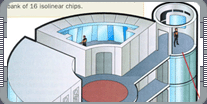
Computer Cores
Computer cores are the very heart of a starship's computer system. They provide enormous amounts of
memory and faster-than-light data processing.
 The computer network of a starship is based around a system of redundant computer cores that process data for
all the ship's systems. Every single system, from life support to weapons arrays and shielding, depends on
the computer cores. A Galaxy-class ship is equipped with three
main processing cores, any one of which can, in an emergency, handle the operational computing load of the
the entire vessel.
The computer network of a starship is based around a system of redundant computer cores that process data for
all the ship's systems. Every single system, from life support to weapons arrays and shielding, depends on
the computer cores. A Galaxy-class ship is equipped with three
main processing cores, any one of which can, in an emergency, handle the operational computing load of the
the entire vessel.
On the USS Enterprise NCC-1701-D, two primary cores were
located across decks 5 and 14 of the saucer section; these usually worked in sync and if one failed the other
could immediately take on its load, with little or no disruption to the ship's operations. The third
computer core crossed decks 30 to 37 in the engineering hull; it was a backup core and was normally only used
if a problem arose in the saucer section or when the ship was separated. Each core incorporated a series of
miniature subspace field generators, which allowed data to be processed and transmitted at fast-than-light
(FTL) speeds. In a Galaxy-class starship, the computer cores are massive, cylindrical structures. The top
level of each primary core, located on deck 5, incorporates a systems monitoring room, the FTL nanoprocessor
units, and access to the subspace field systems, which are located in a separate cylindrical structure to
the side of the main core. This section is known as the upper core; beneath this are six levels of the lower
core.
The cores are connected to the Optical Data Network (ODN) by a series of Micron Junction Links (MJL). They
are supported by a network of 380 optical subprocessors, all of which are linked to the ODN, and many of
which are directly linked to the cores. Virtually every sensor, console, replicator, PADD, and miscellaneous piece of
 hardware installed on a starship is in some way connected to the optical data network and uses the computer
cores for data processing. Backups, engineered redundancies, and automatic service reductions are built into
the system to guarantee that basic available in all but the most grave situations. Pipelines for two
additional ODN systems, located elesewhere in the ship, back up the primary lines. These lines, between
vital terminals and important systems, are also shielded, and if all else fails the radio frequency (RF)
system, through which the communicators run, can also act as an ODN, albeit at a considerable loss of speed.
hardware installed on a starship is in some way connected to the optical data network and uses the computer
cores for data processing. Backups, engineered redundancies, and automatic service reductions are built into
the system to guarantee that basic available in all but the most grave situations. Pipelines for two
additional ODN systems, located elesewhere in the ship, back up the primary lines. These lines, between
vital terminals and important systems, are also shielded, and if all else fails the radio frequency (RF)
system, through which the communicators run, can also act as an ODN, albeit at a considerable loss of speed.
|
|
"BRIEFING: U.S.S. ENTERPRISE NCC-1701-D" - FEBRUARY 2000 ISSUE 10 STAR TREK: THE MAGAZINE COPYRIGHT OF
PARAMOUNT PICTURES.
|